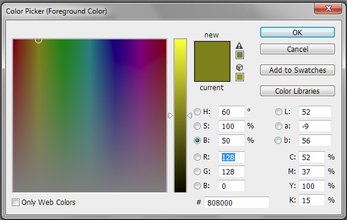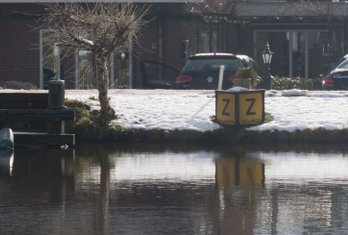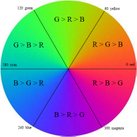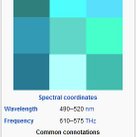The color yellow - names, properties and a surprising discovery
Some words on the color yellow
The color yellow has a pretty unique property: it is only recognized as "yellow" if it's light. This is a statement that most people will agree on. There is a color that we call "dark yellow" but it's more "orange-yellow". As an example, take egg yolk. Not full yellow, darker, but also containing an orange tint.
An interesting question is: what happens when we start with full yellow in RGB and make it darker in the usual way, i.e. by lowering the RGB values?
So, open Photoshop and the Color panel. Full yellow has RGB values 255,255,0. Starting from there, lower the red and green while keeping them equal. It doesn't take long until the resulting color doesn't look yellow any more.
At 128,128,0 - halfway towards black - it has become a brownish green. See figure 1. This is rather surprising if you haven't seen this before. Almost all colors keep their name if you make them darker. Green becomes dark green, red becomes dark red, etc. Not so for yellow. It becomes... what? How do we call this color which is coded 128,128,0 ?
Figure 1
Searching this combination similar to what we did for the LAB elementary colors doesn't take very long. Go to the wiki site "Shades of Yellow" (http://en.wikipedia.org/wiki/Shades_of_yellow) and it is there, at the bottom of the page.
The color is called "olive".
OK then. Olive we call it. I like that name. It's short and recognizable. Plus it shares a few letters with "yellow", which keeps some sort of connection between the two.
The dark yellow experiment
Now on to yet another experiment.
Imagine an object in the real world with a clear, undeniable yellow color. Put this object at a dark spot in a relatively light environment. In the dark corner of a well lit room. Under a table. In the shadow of a sunlit building.
What will happen to the color of this object? Will we stop seeing it as yellow? Will it look brown, or green, or "olive" to our eyes?
I do have a photograph that shows this phenomenon. See figure 2. Just right of the middle, between the water and the cars, a yellow object. Yes, it is yellow, in real life. No discussion possible.
Figure 2
Figure 3
In the picture, it is relatively dark because we face its shadow side, and the surrounding snow is brightly lit by a midday sun. So, how would we call the resulting color, and what are its RGB values?
To start with the second question, I selected the yellow-or-not-yellow part of the sign in the photograph and applied Blur - Average. The resulting color is RGB 111,94,65.
Not a fully saturated color, not full yellow either, more red than green. But we are looking at a real-life object, dirty and maybe worn out. See figure 3 for a rectangle of exactly this color, taken out of its environment. Yellow? Not at all. Greenish brown, dark khaki, muddy olive... you name it. But not yellow.
Now look back at the photograph. What's the color of the object? Ask me, and I'll say: it's yellow. Maybe dark yellow, but yellow it is. Not orange. Not green or olive or brown.
Isn't that fascinating? Do we have another case of simultaneous contrast, color desensitization, or what is it? Our brain compensates for the dark color because we see it's in shade, makes it lighter, and concludes that it must be yellow... all unconsciously.
I love this. It's another evidence of our brain's power in interpreting our environment.
I am sure I'm not the first one making this observation. It's probably documented somewhere, maybe on a website, together with a good explanation and a scientific designation. Yet, I couldn't find it.
If someone can tell me more about this effect, or point me to a website where it is explained, please let me know.
Thanks!
Gerald Bakker, 19 Feb. 2015 / 26 Sep. 2015
Related articles
Photoshop by the Numbers





